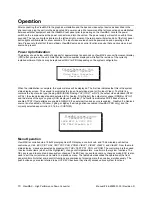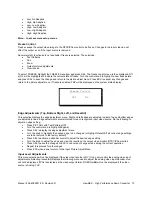
4
ViewMAX – High Performance Down Converter
Manual # 26-6090901-00 / Revision D
Technical Description
The ViewMAX Video Down Converter from Folsom Research, Inc. converts high-resolution video from computer
workstations to standard RS-170A RGB/NTSC or CCIR RGB/PAL formats in real time. S-video (Y/C) and Betacam
(YUV) output formats are provided. Digital video output (serial D1) is offered as an option. Digital Visual Interface
(DVI) with loop-through is also offered as an option. Background mixing allows the input computer video to be
displayed over a background video similar to picture-in-picture and also supports chroma keying to allow features
requiring two video sources (for example, a weather man superimposed on a satellite image). After conversion by
ViewMAX, images can be stored, recorded, and displayed on standard video devices, including video projectors,
video tape recorders, and monitors. ViewMAX video output can also be Genlocked to an external source to allow
connection to broadcast or video editing systems.
The analog RGB input signal can be interlaced or non-interlaced. After being filtered to prevent aliasing, the input
signal is digitized. ViewMAX has a triple 8-bit analog-to-digital converter, one for each (RGB) video input channel.
The sampling frequency of the converters is set to digitize the input at 140MHz, which produces a horizontally scaled
720-pixel image. The 8-bit color conversion process minimizes losses in color fidelity.
Vertical scaling is performed via a weighted interpolation algorithm, which has been designed to preserve the spatial
quality of the original image without line dropout. The horizontally scaled image is transferred internal memory stored
in YCbCr 4:2:2 format. The vertical scaling occurs after the image is retrieved back from internal memory. The
resultant digital image is converted to analog RGB format with three 8-bit digital-to-analog converters. A digital
encoder is used to provide broadcast-quality NTSC or PAL output.
Control is provided by a user-friendly front panel or remotely via an RS-232 serial interface or an RS-485
multidropped serial interface.



























